Introduction
If you’re seeking inspiration for the design and construction of an OTC-X1 Circular Foil Craft, (spacecraft, flying saucer) these documents may help. I describe their provenance; their condition; where they were found; and where they are, today. I’ve also included my speculation on the physical limitations of his spacecraft’s design and my opinions on Otis T. Carr and his business practices.
Another design worth exploring is Alexey Chekurkov’s Graviflier. Unlike the OTC-X1, his design has apparently been proven to work. It’s components, circuitry, and schematics have recently been publicly shared by an engineer, who recieved one of the Gravifliers built by Alexey. For more information, please read my post Alexey Chekurkov’s Graviflier.
Atoms for Peace
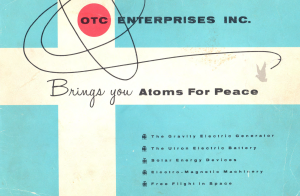 Atoms for Peace is marketing collateral indicative of the c.1950’s atomic-age mind-set. The late Otis T. Carr may have designed and printed this 4-color pamphlet.
Atoms for Peace is marketing collateral indicative of the c.1950’s atomic-age mind-set. The late Otis T. Carr may have designed and printed this 4-color pamphlet.
Norman Colton, Director of Public Information for OTC, Enterprises, was 22 years old at the time he worked for Carr. Prevously, he been fired from Aberdeen Proving Grounds for falsifying records; he was investigated — but not prosecuted — for fraud and writing bad checks. The FBI has a reports on him stirring up trouble at a local library, insisting all its science books be replaced with Carr’s works. He lived at home with his mother.
Scientists who attended Colton’s presentations describe the information as “electronic gobbledygook”. Complaints from investors attracted the attention of the FBI.
Carr is featured in a few surviving WOR radio recorded interviews with Long John Neble. They discuss his project’s goal: to fly to the moon. Carr mentions his attempts to get $20 million from the government to build his craft; mentions his legal trouble and denies unlawfully selling securities. Margaret Storm, whose name appears in an indictment, is also present.
Some say that Carr was innocent, wrongfully prosecuted to protect secrets of anti-gravity and free energy. Based on my research, it’s apparent they had a solid case against Carr. In fact, Otis Carr’s own words, printed in his newsletters, easily seals the case against him. Carr plead not guilty and was ultimately imprisoned for selling unregistered securities.
Carr’s guilt or innocence notwithstanding, I get the impression he was a big dreamer with a big ego who was a fly-by-the-seat-of-your-pants businessman. He seems to have had laser-focus, almost like: Damn the torpedoes, full steam ahead!
In retrospect, his lack of common sense put him in legal jeopardy, as evidenced by 1) hiring an eccentric young man (Norman E. Colton) who was idealistic and lacked discretion to be an effective Director of Public Information; and 2) Carr’s having made written requests for specific nuclear secrets. Can you imagine the scrutiny any of us would suffer if we made similar written requests today?
 Carr was clearly a man of action. I can’t knock him for that. In many ways, he succeeded. His vision and hope for the future were admirable — raw and untempered by common sense, but admirable. At least he tried, whereas many aspiring business owners do nothing more than think, their ideas becoming no bigger than the brain cells they occupy. He was apparently a talented artist fully capable of illustrating his vision, which included comparing himself to, and featuring his likeness alongside, great inventors and renown geniuses — Edison, Galileo, Copernicus, and Einstein.
Carr was clearly a man of action. I can’t knock him for that. In many ways, he succeeded. His vision and hope for the future were admirable — raw and untempered by common sense, but admirable. At least he tried, whereas many aspiring business owners do nothing more than think, their ideas becoming no bigger than the brain cells they occupy. He was apparently a talented artist fully capable of illustrating his vision, which included comparing himself to, and featuring his likeness alongside, great inventors and renown geniuses — Edison, Galileo, Copernicus, and Einstein.
He also conceptualized and pitched a manufacturing campus for the construction of free-energy systems and electro-magnetic gravity-defying spacecraft . . . and people loved his dream – so much so – they paid him to be a part of it! Off of Bear Valley Road, Hesperia/Apple Valley, CA, The Understanding Group helped bring to fruition his dream for a manufacturing campus.
Otis T. Carr and associates opened “Plant No. 1” at the former Osbrink Plant, “site of Plant No. 3”. Is it a coincidence that Carr would include a plant number on his brand new shiny billboard, as well — “Hesperia Plant No 1“? Osbrink was contracted to build tail components for bombers. As I recall from my research, I think the plant had been built and then shut down due to advancements in aviation technologies or advancments in aircraft desgins. In any case, the tail components were no longer needed. The location of OTC Enterprise and associates is occupied these days by a construction company, the billboard is long gone.
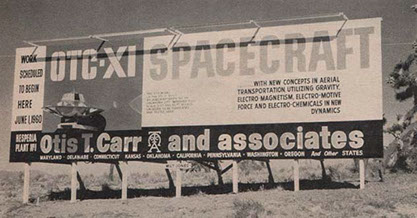
Ralph Ring has mentioned Otis Carr not liking the term ‘flying saucer’. He preferred ‘Spacecraft’ or ‘Circular Foil Craft’. Ultimately, Carr’s Spacecraft Plant No. 1 was raided by the US government and shut down. According to Ralph, everything was confiscated, including two large craft that were hauled off on lowboy trucks.
Atoms for Peace is one of the few remaining relics of Carr’s dream.
OTC-X1 Flying Saucer by Walter Nowosad | Redbubble
Dimensions of Mystery
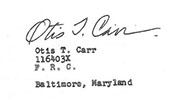 Otis T. Carr was a Rosicrucian, who said the design secrets for constructing an operable craft are encoded in his collection of poems, Dimensions of Mystery. One of the members of my team took a copy of Carr’s book to a Rosicrucian, who confirmed it was written using Rosicrucian terminology. There has been debate among OTC-X1 enthusiasts over the meaning of several passages. Discussions have pivoted around Carr’s use of proper names representing periodic elements and whether the layout itself – the paragraphs patterns – and word-order could represent cyphers. Afterall, Carr stipulates the book’s format not be alerted. To this day, none have agreed to its meaning, and we are no closer to constructing an operable OTC-X1 Circular Foil Craft.
Otis T. Carr was a Rosicrucian, who said the design secrets for constructing an operable craft are encoded in his collection of poems, Dimensions of Mystery. One of the members of my team took a copy of Carr’s book to a Rosicrucian, who confirmed it was written using Rosicrucian terminology. There has been debate among OTC-X1 enthusiasts over the meaning of several passages. Discussions have pivoted around Carr’s use of proper names representing periodic elements and whether the layout itself – the paragraphs patterns – and word-order could represent cyphers. Afterall, Carr stipulates the book’s format not be alerted. To this day, none have agreed to its meaning, and we are no closer to constructing an operable OTC-X1 Circular Foil Craft.
Dimensions of Mystery PDF Download
Machine Shop Schematics
 These original drawings – X1 Prototype Design – were created in 2016 by an X1 enthusiast in Australia. They were used by machine shops to mill each component. If you decide to construct a model craft, know that this is just one implementation of Carr’s design. These machine shop schematics do NOT include electrical schematics. It provides a mere glimpse into the cost and complexity involved in designing and constructing a model craft that does not operate.
These original drawings – X1 Prototype Design – were created in 2016 by an X1 enthusiast in Australia. They were used by machine shops to mill each component. If you decide to construct a model craft, know that this is just one implementation of Carr’s design. These machine shop schematics do NOT include electrical schematics. It provides a mere glimpse into the cost and complexity involved in designing and constructing a model craft that does not operate.
Where can I buy a UTRON?
This is a common question. It’s not like you can drive to a big-box store to pick-up a set of Dewalt UTRONs. Rest assured: this is an expensive hobby; so, before you start tossing money into the wind, think carefully about how to make your design work. Building a physical representation of Carr’s OTX-X1 drawings will not produce gravity-defying levitation.
The volunteers who were on my team are exceptionally talented engineers. They’ve analyzed the hell out of this design. We’ve had many hours of discussions and still have not produced a functional craft. If you have zero engineering knowledge, zero physics knowledge, and if you know nothing about electronics and magnetism, I urge you to reassess burning your hard-earned money on custom-made UTRONs. I’m not saying don’t do it. I’m saying be smart about your design…be safe…and good luck!
OTX-X1 Schematics v.1 PDF Download
OTX-X1 Schematics v.2 PDF Download
Hollow Utron Schematics PDF Download
The Hollow UTRON
The X1 enthusiast in Australia says the hollowed-out part of the UTRON should be spherical, not cone shaped as seen in the illustration, below. An inner spherical hollow should consume approximately 50%-75% of the inner volume of the UTRON. The OTC-X1 machine shop schematics, reflect overall UTRON dimensions based on the scale of their design.

This image, along with the hollow UTRON schematics, may help you create a design of your own. The illustration above reflects the results of one of our conversations regarding the design of a two-part UTRON. The engineer designed it to employ a snap-together fastener. It has not yet been manufactured or tested by anyone; whereas, the hollow UTRON schematics features threads, exactly like the one I saw during my visit with an acquaintance of Ralph Ring.
The machine threads were located at the periphery of the UTRON’s spherical hollow. They were very fine and were milled into the concave section of each half. Male threads extended a few millimeters above the hollow of one cone to mate with the female threads of the other.
The threaded design allows the two halves to be snuggly screwed together such that the seam at the equator was imperceptible. At first gander, I didn’t notice it was a two-piece UTRON, until it was unscrewed.
If you want to make one of these, give careful consideration to the thickness and length of the pins. I’ve received reports that the UTRONs they made bent or broken off altogether during testing.
The Australia X1 guys who created the machine drawings say,
“The new set of drawings enables a harmonic relationship with all parts of the craft’s geometric design. The original workshop design specifications are correct in their dimensions, though this UTRON design allows for the hollow to be filled, if desired. The hollow has a specific correlation to the geometry of the OTC-X1. Its relationship with the inner disk and outer hull is geometrically proportionate to the speed of light.”
In other words, the geometric relationships between inner rotating disk (Accumulator Frame on which UTRONs are mounted), outer hull, and the UTRON’s spherical hollow is proportionate to the speed of light. During a Skype call with the Australia guys, they mentioned a similar geometric & light-speed relationship exists with the Giza pyramids.
Exactly how this will relate to your design is up to you. Although they felt it important to express this bit of information, exactly how speed and physical measurements correlate are a mystery to me. In other discussions with the lead engineer of my team, I’d heard similar comparisons with light speed when discussing coil-lengths. Perhaps engineers reading this will understand?
Will the threaded UTRON be watertight, or will it leak?
It may or may not leak. I pondered whether vibration from normal operation and heat from current flow would loosen the two halves, causing its contents to spill. Carr’s Toy Kit plans mention putting electrolytes inside. There’s also been some discussion of filling them with honey. If the threads aren’t enough to make it watertight, I thought that perhaps a fine groove or channel could be milled into the flat facing sides (somewhere between the threads and the equator) to accommodate a small rubber grommet. This way, a fluid-tight fit could be made.
Are UTRONs supposed to spin?
According to Ralph Ring, no. They’re supposed to be allowed to free-wheel. According to other enthusiasts and theorists, they’re supposed to be wrapped in wire (just as Carr stipulates), energized, and motorized.
What if mercury were placed inside the UTRON?
NOT a good idea.
! ! ! WARNING ! ! !
MERCURY DISSOLVES ALUMINUM ON CONTACT.
Do NOT attempt to fill your aluminum UTRONS with mercury. While aluminum is protected by a surface layer of inert transparent oxide (AL2O3) that forms rapidly in air and provides excellent corrosion resistance, any elemental aluminum exposed by a scratch would allow the mercury to combine with it to form an amalgam, thereby destroying the aluminum.
OTC-X1 Toy Model Plans
 Otis T. Carr’s Toy Model Plans were direct mail marketed. The mailer was a one-color half-tone print, 17″ x 11.5 inches, printed on two sides, folded in half and tri-folded for addressing and mailing. At this time, I don’t have permissions to post it. For now, I’ll share a snippet of its sensational wording and humorous parenthetical. I’m sorry, this one just gave me a chuckle to read. Amongst other things printed on the mailer, it reads,
Otis T. Carr’s Toy Model Plans were direct mail marketed. The mailer was a one-color half-tone print, 17″ x 11.5 inches, printed on two sides, folded in half and tri-folded for addressing and mailing. At this time, I don’t have permissions to post it. For now, I’ll share a snippet of its sensational wording and humorous parenthetical. I’m sorry, this one just gave me a chuckle to read. Amongst other things printed on the mailer, it reads,
Now! New! Build this AUTHENTIC MODEL of the REVOLUTIONARY OTC-X1 SPACE CRAFT!
Detailed Engineering Plans Now Available at Popular Prices!
ANIMATE IT! SEE IT WORK! EVEN FLY IT YOURSELF! (Under proper qualification, of course)
If you’re curious about what Otis Carr meant by popular prices, here’s your sign: $5 each; two for $9; three for $12. Adjusted for inflation in 2022, that $48, $87, and $116, respectively. The set of plans are rather large, actually. They include drawings & instructions on how to build a model of the OTC-X1. My team referenced it and other documents during their research and development efforts to design a test bed that could lead to building an operable prototype.
The downloadable copy of the plans is much clearer than the copy I found In Ralph Ring’s white binders. It was discovered and scanned by one of the guys on my team. Although it’s in black and white, he told me that each page of the original has its own color, like a rainbow. Compare the details of these plans with Carr’s US Patent.
If an OTC-X1 were built, would it work?
That’s the $64 question, isn’t it? For the sake of discussion, let’s assume an OTC-X1 spacecraft is capable of defying gravity. Closely examining Otis T. Carr’s model plans and US Patent — right or wrong — I have many questions and concerns. Here’s where we put on our thinking caps, my friends.
Balance and Rotation
According to Otis T. Carr, there are only two moving parts — 1) the inner accumulator frame and 2) the outer hull, which are affixed to and rotate about a central spindle or axle, like a gyroscope. The passenger cabin is ignored by Carr and assumed to be stationary. Think about where and how the cabin is mounted to his spacecraft. It can’t be mounted to the hull or accumulator frame, because they rotate; so, it must be attached to the spindle, which begs the question:
What sort of mechanical magic prevents the passenger cabin from rotating — potentially thrusting its passengers into a vomit-vortex blenderland?
As a child, I had one of these tops.
The red handle is analogous to the passenger cabin. It remains stationary in your hand, as you spin it up. However, when you release the handle, it rotates along with the rest of the top. For the remainder of this analysis, let’s ignore this and assume the OTC-X1 cabin remains stationary. We still have other problems.
Centrifugal Force
If a forty-foot flavor of this spacecraft were constructed and spun-up, centrifugal force acting against the dense mass and weight of twelve copper-wire-wrapped iron-core electromagnets mounted to the internal periphery of its rapidly spinning aluminum-skinned hull could rip it apart. Imagine all that outward force tugging on its mounting points: bearings attached to the spindle.
Switch focus to the second spinning assembly: an internal Accumulator Frame with its mysterious dual opposing conical shaped ‘Central Accumulator’ wrapped around the same spindle. What’s inside, Ralph wasn’t sure when I asked him. Six hefty-looking metal capacitor plates and six metal UTRONs are mounted to the disk. The disk itself is assumed to be an insulator material – relatively non-conductive.
Can such a disk carry all that weight and not disintegrate under load? Just think about the weight of the metal mounted to it. Consider how the disk would be fastened to bearings on the spindle. A variable and increasing load would be imparted to the bearings, its fasteners, and the molecular strength of the disk’s material itself, as it increases RPMs.
Even Nikola Tesla experienced disks flying apart when scaling up his spinning disk dynamo. The dynamo was powerful but scaling it up lead to disk-disintegration. Here’s a video demonstration of a Compact Disk (made of an insulator material) being spun up with nothing attached to it. Now imagine compromising its structural integrity by cutting six square holes into to allow clearance for the UTRONs; drilling holes into it to mount trunnion mountings for the UTRONS and for mounting thick aluminum ‘Capacitor Plates’. Think about all that weight tugging at the spindle and disk. How long would it spin before ripping itself apart?
Power
A researcher, who contacted me a number of years ago described his meeting with one of Carr’s associates. He imparted this anecdote: Otis ignored advice to not energize the craft with the amount of power he wanted. As predicted by his associate, the overpowered spacecraft’s wiring became fuses and fire ensued.
No matter how strong your beliefs, no matter how much money you throw at building a flying saucer, the laws of physics will be ever-present, waiting to bite ignorant posterior regions – hard.
Structural Flex
How would this counter-rotating gyroscopic rig be engineered and mechanically tuned for perfect balance so that it wouldn’t wobble, cause the counter-rotating parts to collide, or pry itself apart? Examine the passenger cabin again. Look at how wide it is. Look at where it mounts to the spindle. Would you build a house on the tip of a pencil? Assuming you could make it work, add passengers and crew milling around inside. What prevents the pencil-house from flexing? All metals flex. The longer the span, the more it bends.
Out for a walk one day, I witnessed a single-car Big Mac attack (that’s c.1980’s Military Police jargon for traffic collision caused by a driver’s sudden need for a Big Mac). This driver made a last-ditch effort to take the onramp for northbound Interstate 5. The car’s front wheels turned, as designed. However, the car did not respond well. Kinetic energy did not allow the car to immediately turn 90 degrees. Rather, it navigated a slight curve and careened into, then over to top of, a healthy cement curb. The vehicle came to its final resting place in a patch of ice plant, the driver uninjured and in complete denial.
Force applied at the front tire’s sidewall at impact with the curb was enough to snap the axle. The tire of this driver’s car is the passenger cabin. The axle is the spacecraft’s spindle. The force that broke the axle is the weight of the passenger cabin coupled with passengers and crew milling about inside. The driver are kind folks who dream of flying magic carpets. I’m sure there are engineers out there who are better versed at explaining the physics.
Friction and Heat
Unlike Otis’ Patented Amusement Device with its spindle firmly anchored to the ground, guaranteeing the passenger cabin remains stationary, an airborne flavor of this machine would have no benefit of an anchor to stop the cabin from spinning. Friction imparted to the spindle by the two counter-rotating assemblies would cause the cabin to rotate. How fast it would rotate is anyone’s guess. Assuming this craft is built and manages to get off the ground. Imagine what would happen if the accumulator frame bearings failed.
I’ve actually seen this happen to a car on the Interstate at 70 MPH. When an axle bearing fails, a great deal of heat and smoke is produced. The seized bearing grabs hold of the turning axle, causing it to turn red hot. During flight of an OTC-X1 spacecraft that relies on bearings for its stability, if the bearings for a 40′ in diameter rapidly spinning disk seizes, there’s nothing to prevent this spinning freight train from grabbing the spindle, imparting all its kinetic turning force (torsion? torque?) to a spindle assumed to be stationary. This immense rotational force would immediately transform the passenger cabin into a blender, ruining the day of all its occupants.
Oh, what an adventure that would be!
A better solution?
Assuming this design performs as expected, think of it as a gravity generator or engine. Don’t mount a cabin directly to it. Rather, attach many of them to a larger vessel. That way, if a mechanical bearing seizes, the resultant force could be dissipated into some flavor of dampening mounts…then again, all of this is theoretical, based on assumptions that Carr’s design is capable of lofting us safely to the moon.
US Patent 2,912,244 AMUSEMENT DEVICE
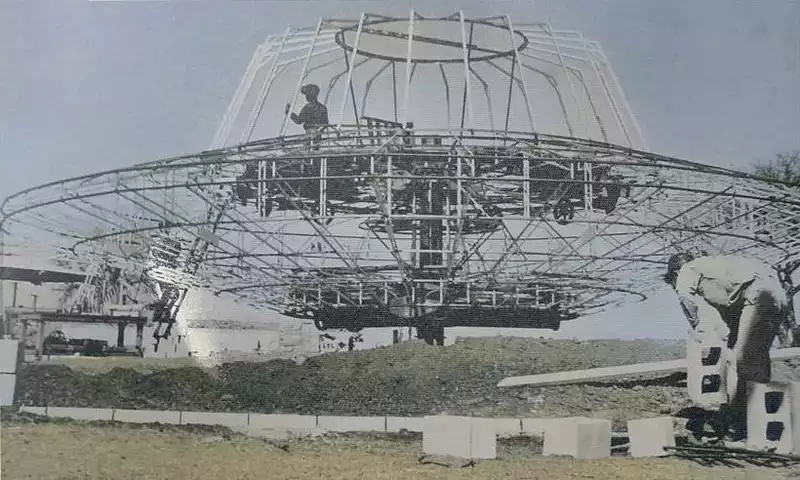 Carr’s US PATENT is for an amusement park curio designed to be firmly anchored to the ground and incapable of flight. The picture, colorized and sent to me by one of my overseas YouTube viewers, shows one of these devices under construction at an amusement park in Oklahoma.
Carr’s US PATENT is for an amusement park curio designed to be firmly anchored to the ground and incapable of flight. The picture, colorized and sent to me by one of my overseas YouTube viewers, shows one of these devices under construction at an amusement park in Oklahoma.
Notice the large metal pipe in the middle. Cemented to the ground, it supports the entire unit. Upon closer examination, you can make out framing for the ‘Central Accumulator’. There’s also a set of spoked wheels under the passenger cabin, which are called out in the patent. When the guys in Australia were building their model and analyzing the contents of both, the patent and Carr’s Toy Plans, they stipulated the wheels and bearings of this device would not be part of a functional craft.
US Patent 2,912,244 PDF Download
Tesla’s Notes on Forbe’s Unipolar Dynamo
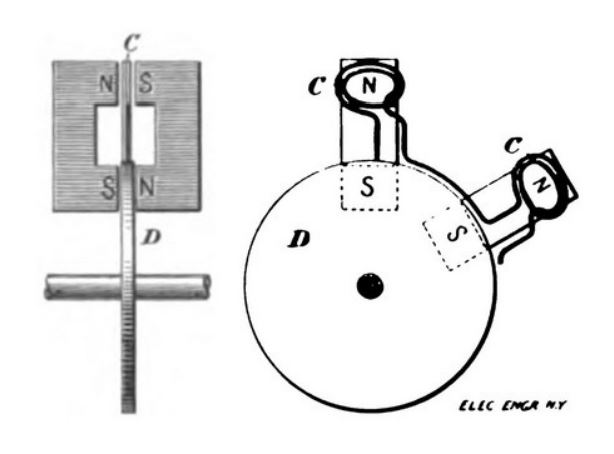 Otis T. Carr claims to have known and learned from Nikola Tesla. Ralph Ring, who worked with Carr at OTC Enterprises in Apple Valley, CA, recalls instances of Carr retiring to his office to pour over a coveted blue binder of notes. Other researchers who had met Carr before he passed in 1983, informed me of his impressions. Carr greatly valued the notes; believed they were stolen; and desperately wanted them back. The author of the blue binder’s notes was none other than Nikola Tesla.
Otis T. Carr claims to have known and learned from Nikola Tesla. Ralph Ring, who worked with Carr at OTC Enterprises in Apple Valley, CA, recalls instances of Carr retiring to his office to pour over a coveted blue binder of notes. Other researchers who had met Carr before he passed in 1983, informed me of his impressions. Carr greatly valued the notes; believed they were stolen; and desperately wanted them back. The author of the blue binder’s notes was none other than Nikola Tesla.
Where is the binder today? One of the members of my team has an idea; but I’ve promised not to reveal the name. In the past year, I’ve done some additional research; as, a relative of the person contacted me. That relative confirmed the mental instability of that person and is unaware of such a binder existing.
Although Carr’s toy model plans and his US Patent 2,912,244 Amusement Device don’t include electrical schematics and call out specific materials needed to construct an operable craft, a volunteer member of my team – an anonymous Electrical Engineer and Tesla enthusiast – suggests Forbes’ Notes on a Unipolar Dynamo may provide clues for wiring. Conversations with the Australia guys, about their plan to implement this kind of wiring scheme, lead me to produce a video, Wiring the OTX-X1. It was my feeble attempt at explaining how the OTC-X1 could be wired…and oh, was I stylin’! Ya baby! Ya gotta love that salt & pepper beard and goofy hat!
Tesla’s Notes on Forbe’s Unipolar Dynamo PDF Download
Simple experiments on Lenz’s Law and Faraday’s Law of Induction provide clues as to how electricity and magnetic force may leverage rotation. There’s nothing new here. It’s used all the time in motors. Generating a levitation effect as a byproduct of spinning electrically charged plates and magnetics remains to be proven with Carr’s design. On the other hand, Alexey Chekurkov, who studied these plans and many other ideas, took a modified approach to spinning disks. He has demonstrated successful levitation on his YouTube channel. I’ll save this topic for another post.
OTC-X1 Experiments, Walter Baumgartner
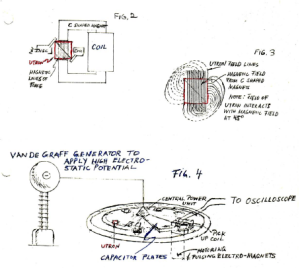 In 1984, Walter Baumgartner constructed an OTC-X1 prototype and wrote about the UTRONIC effect. If you visited Kerry Cassidy’s website seeking more information on Ralph Ring and the OTC-X1, you may recognize a few of the sketches in this picture. When I found them posted on Kerry’s website, I wondered, where’s the rest? Where’s the written parts to explain the figures? Where’s the beef? Kerry’s interview with Ralph made no mention of the drawings.
In 1984, Walter Baumgartner constructed an OTC-X1 prototype and wrote about the UTRONIC effect. If you visited Kerry Cassidy’s website seeking more information on Ralph Ring and the OTC-X1, you may recognize a few of the sketches in this picture. When I found them posted on Kerry’s website, I wondered, where’s the rest? Where’s the written parts to explain the figures? Where’s the beef? Kerry’s interview with Ralph made no mention of the drawings.
And by the way, Kerry Cassidy and Bill Ryan of the now-removed YouTube channel, Project Camelot, motivated me to shoot my own video interviews. Later, I was honored to assist Kerry on one of her interviews with the late William M. Tompkins, where I learned of her kindness and generosity…but, that’s a story for another post.
Before I met Ralph, I found another interview. In it, Ralph is seated at a dining room table. There before him, were a couple of thick white binders packed with papers. I wondered what were in them. Excited to watch the video to the end, I assumed they would open those binders and discuss that flying saucer model sitting alongside of them.
Nope. It didn’t happen.
During one of my visits with Ralph and Marsha Ring at their home in Paradise, CA, I recognized the disk in his garage. I should say, regarding the disk, there wasn’t much to it at all. Since Ralph was escorting me through the garage to his house, I didn’t examine it closely. It looked like a couple of plastic plates. No mechanisms. No circuitry. Barely a mockup. In any case, I thought, ah ha! That reminds me. I asked Ralph if I could have a look at those white binders. He retrieved them from a shelf that was sitting outside on a covered deck. He granted me permission to borrow them. I took them home and made high resolution color scans of everything that might be of value. There wasn’t much.
Inside, I discovered many of the papers were clipped or copied newspaper and magazine articles related to Otis T. Carr and other flying saucer and UFO stories. There was a glossy portfolio of marketing material for a company in Davis, CA — West of Sacramento across the causeway — that had designed and built protypes of a flying car shaped like a flying saucer. It was a crude version of today’s VTOL (Vertical Take Off and Landing) aircraft. The craft was levitated by several gasoline engines. I remember reading a newspaper article about this project during the mid to late 1980’s when I was attending CSU, Sacramento. Ralph got to see a demonstration of it. With a sour tone of voice, he remarked it was incredibly loud.
Atoms for Peace was an original; but it had been disassembled by someone else that Ralph had loaned it to. As such, it was in poor condition – It had three-ring binder holes that were torn-out. The paper was yellowed and worn.
The OTC-X1 Spacecraft Model Plans were bad copies of the original and it was missing pages. Small print was blurred, impossible to read, or had been curled due to poor alignment on a copy machine. The copy available for download on this webpage is complete and easier to read. A generous volunteer on my team located an original online. He purchased it, scanned it, and shared the file with me.
Examining the articles about Carr, they seemed to have been printed from microfiche or were copies of a copy of a copy taken from an abused library Xerox copy machine that had seen better days. If you survived the 70’s pre-Internet, you know exactly what I’m talking about. A few of the newspaper and magazine articles sported yellow highlighter marks. The overall condition of the papers in those binders was fair-to-poor, somewhat musty and damp from ambient exposure to the elements.
Discovering Walter Baumgartner’s paper was an absolute treat. When I saw the sketch of the van de graft generator, I exclaimed AH HA! THIS is where Kerry Cassidy got that picture! And BONUS! There’s an entire article wrapped around it! I pondered why Kerry didn’t get a copy of the entire paper and post it herself. In any case, we have it now.
As you may know, the Paradise, CA fire took Ralph and Marsh’s home with everything in it, including the white binders and some Tesla documents, which I never knew he had. Since I had made scans of some of the white binder materials, I gladly printed it and sent it to Ralph, along with DVDs interviews they had given to me many years ago. I was glad to help replace at least a few of the things they had lost.
During an off-camera conversation with Ralph in 2011, he mentioned that Baumgartner was frustrated with limited success. According to Ralph, he was only able to achieve modest levitation, an inch or so. I was shocked, I’m sorry, what? At least he succeeded, right? You’re telling me he got it to work?
As an aside: no reference to Buamgartner’s limited success is mentioned in the paper.
Ralph went on to explain why Baumgartner didn’t completely succeed. Ralph passionately explained that everything is conscious. You have to be in the right mind-set. Conscious energy affects whatever you’re making. He went on to recount that Carr thought similarly and would send people home if their mind wasn’t right. Paraphrasing Ralph, “If you weren’t in the right mindset, go home. Don’t infuse your work with discordant energy”.
OTC-X1 Experiments by Walter Baumgartner PDF Download
The UTRONIC Effect
According to my team’s interpretation of the late Walter Baumgartner’s writings, the UTRONIC effect taps the atom’s energy, somewhat similar to gently cracking an eggshell. Unlike conventional atomic energy, it does not require brute force. At least this is the theory. The pods say there are conditions that must be met to create a UTRONIC effect.
You must have the UTRON shape, dual facing cones, round when viewed from the top and square when viewed from the side; and,
-
- it must be made of paramagnetic metal, such as aluminum,
- it must incorporate a hollow sphere in the middle, which would be filled with some flavor of matter; and,
- it must be wrapped in wire from tip to tip,
- The UTRON must be in motion (rotating or orbiting); and,
- while in motion, the UTRON must be exposed to a magnetic field generated by an electromagnet.
The Pods feel it’s worthy to note that in his WOR radio recorded interviews with Long John Neble, Otis T. Carr never mentions the use of permanent magnets.
Document Downloads
Atoms for Peace
Dimensions of Mystery
OTX-X1 Schematics v.1
OTX-X1 Schematics v.2
Hollow UTRON Schematics
OTC-X1 Model Plans
US Patent 2,912,244 Amusement Device
Tesla’s Notes on Forbe’s Unipolar Dynamo
OTC-X1 Experiments by Walter Baumgartner





